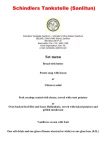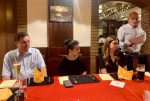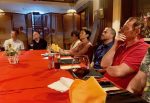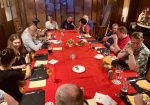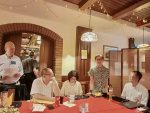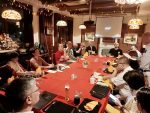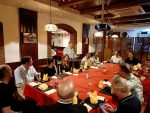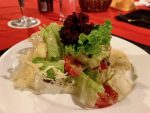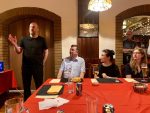14 September 2021 dinner
Architect John van de Water talked to Rotary during our dinner in Schlinders Tankstelle; a very interesting presentation on the topic: “What Design Can Do”.
Dutch architect John van de Water is co-founder of NEXT architects Amsterdam [in 1999] and NEXT architects Beijing [in 2004]. Over the years, NEXT projects has cultivated a strong name in contextual and innovative design. John has received numerous awards, such as the biennial ‘Top 100 most influential architects in China’ by Architectural Digest magazine in 2017 and 2019. In his talk: ‘What design can do?!’, John questioned the concept of sustainable design for China. What kind of design could that result into for existing and future cities?
See the China Rose Museum, now closed that was the main venue for the ‘World Rose Convention 2016’. It is located exactly on the Beijing Central Axis.
The “chicoree salad” was disappointing (chicoree? where? is it supposd to be endive?) but the pork escalope was very good. And by the way, try their pork ribs, the best in Beijing.
More about John van de Water from NEXT Architects
In 1999, four fresh out of school young Dutch architects, after four months of traveling and research, inspired by the architectural and structural innovations in many major cities, set up an architectural firm, NEXT, in Amsterdam, with a mind to create the next generation of architecture. While the young architects explored and experimented with building and furniture designs in its early days, a 2004 email to invite this young architect firm to participate in the forthcoming Beijing Olympics, changed the fate of the young firm, as well as some of the city landscapes in the following 17 years in China.
In his insightful talk, John recounted the cultural clashes, the bewilderment, the encountering, and then navigating within alien culture and business practices. On his arrival in China, John was awed by the long history of the cities he traveled to, like Luoyang, and also by the massive transformation from rural villages to metropolises at breakneck speed, like Shenzhen. In the end, it was a narrative of his eventually adopting and integrating the alien cultural and business practices with his western training and methodology. By sharing many of his design concepts, John demonstrated that architecture was more than just designing and constructing buildings, but it was a process of exploring space and its surroundings, incorporating functionalities and utilities, creating conveniences for and accommodating the habits of the human occupants, and eventually a sustainable design concept that can embed local cultural characteristics.
See: http://www.nextarchitects-china.com/ (under construction)
